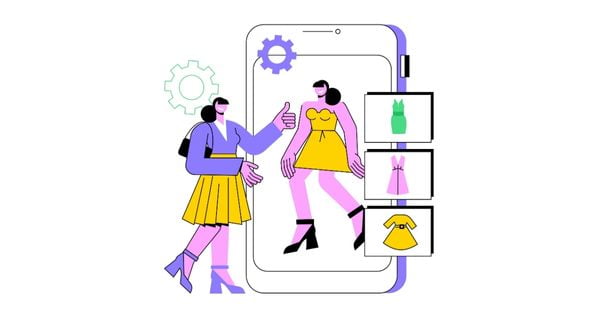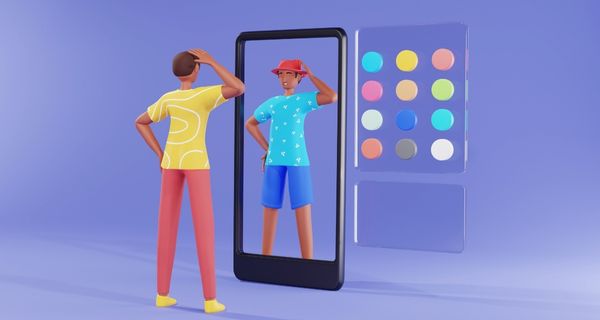One of the most exciting developments in E-Commerce, fashion, and retail has been 3D and augmented reality, which enables us to create and interact with 3D objects in a real-world environment. 3D augmented reality has immense potential to enhance product visualization and hence power the E-Commerce market. You can get a better idea of this new-gen innovative technology’s market value, which stood at $25 Billion as per the statistics and analytics agency Exploding Topics. Industry experts and leaders are projecting a whopping $50 billion in revenue by 2027 with a CAGR of almost 16%. Considering the growth rate of 3D AR today, the projections seem promising, especially with a more interactive 3D ecosystem being prepared for mainstream market adoption in the form of Metaverse.
This article will explore what 3D augmented reality is, its potential applications, and its use in different end-product forms. 3D augmented reality has a broad possibility of turning potential audiences into customers. Research shows that every 3 of 4 adults (<44 years) is familiar with this blend of 3D and AR technologies. By the end of this article, you will have a comprehensive understanding of 3D AR and its potential to transform the way we interact with the world around us.
What is 3D Augmented Reality Product Visualization?
Product visualization in 3D has been there for a while now. You must have seen plenty of products in 3D on E-Commerce websites. And now AR is adding oomph to it. AR-powered 3D product visualization is an innovative idea that allows customers to visualize and interact with products in a three-dimensional space. This technology lets customers virtually place products in their real-world environment using a mobile device or AR headset, giving them a realistic and immersive experience. Let’s realize the true potential of product 3D AR view in mainstream industries like e-commerce, fashion, and retail.
E-Commerce
3D AR view of products has become a game-changer for online shopping applications. With the help of this technology, customers can see how the product will look in their physical space before making a purchase, providing them with a better understanding of the product’s size, texture, and color. Thus, it significantly reduces the rate of product returns and increases customer satisfaction, as customers can make informed purchase decisions.
Retail
3D AR Product Visualization is key to transforming the in-store shopping experience. Retailers can use this technology to display their products more engagingly and interactively, allowing customers to try on virtual clothes and accessories, see how furniture will look in their homes, or try out makeup virtually. This technology helps retailers stand out from competitors and provide customers with a more personalized shopping experience.
Fashion

The fashion industry has also embraced 3D AR Product Visualization to showcase their products to customers. When a customer can see virtual avatars embracing their favorite clothes, they get a fair idea of how they might look on them. Also, AR technology allows customers to virtually try on clothes, shoes, and accessories and see how they look on their body type and skin tone. This technology enhances the customer experience and saves time and money spent on physical product samples, photo shoots, and model fittings. Fashion brands can also use this technology to create immersive virtual fashion shows and presentations, giving customers a front-row experience without traveling.
Other sectors using 3D & AR to meet their business needs
3D augmented reality can be utilized in numerous business sectors and industries, which play a crucial role in our daily lives. Here is a complete overview of different other sectors using it in their business application.
Advertisement & Marketing
Besides product visualization, brands can use 3D and AR in numerous other ways to turn their traditional marketing collaterals into viral-worthy content, thus adding oomph to their brand advertisements and marketing that engages customers. It allows brands to showcase their products and services in a visually stunning and memorable way, increasing brand awareness and recognition. With 3D AR technology, brands can create a unique and personalized customer experience, increasing engagement, sales, and brand loyalty.
An example of using 3D AR in business advertising and marketing is the marketing strategy of ‘Hero,’ a major player in the Indian Automotive Industry. It launched an AR-based Instagram filter for its EV, allowing users to collect dropping helmets on the screen by moving their heads. The strategy took off successfully, and the brand gained traction in marketing its product & reaching a global audience.
Edutech
With 3D AR, online education can offer immersive and interactive learning experiences, allowing students to explore and interact with complex concepts more engagingly. For example, students can use their devices to see a 3D human heart model and learn about its different parts. You might have watched those animated videos on video streaming platforms like YouTube, where the same things are explained with 3D animations. A 3D augmented reality app for the same can be considered a Level-up.
Healthcare
3D AR can be used for developing innovative healthcare solutions in the form of apps, which can provide an immersive experience for users and patients to keep up with their medication and appointment reminders. However, this is not the only application of 3D augmented reality in the Healthcare sector; it can also be used in training and demonstrative surgeries.
Gaming
Gaming is also one of the most prominent use cases of 3D AR. The technology can create augmented reality games that blend virtual and physical environments. One such experience is where users can use their devices to see virtual creatures in their real environment and interact with them as they blend into reality.
Training and Upskilling in Complex Environments
With the help of 3D AR, companies can create training simulations in hazardous environments, allowing users to practice and improve their skills in a safe environment. For example, a firefighter can use a device to see a 3D model of a building on fire overlaid onto their virtual environment and practice navigating through it. NASA has also planned to use 3D and augmented realities to build real-life environments replicating the environment and situation of Mars’ surface and train astronauts for their upcoming 2030 mission to send astronauts to the Planet Red.
How to build 3D Augmented Reality Experiences?
Creating 3D AR solutions is now easier than ever, thanks to cloud-based platforms that offer a user-friendly interface. By leveraging 3D and augmented reality technologies, users can build 3D AR experiences that can be integrated into various E-Commerce and native websites.
With PlugXR’s simple and intuitive interface, you can easily create 3D AR product visualization in record time without needing hefty coding or dedicated technical expertise. Anyone can create 3D Augmented Reality experiences using our cloud-based, drag & drop platform in these simple steps:
Step 1: Choose a 3D Model
The first step in creating a 3D AR object is to choose a 3D model. There are multiple ways to do this; you can do it either by downloading a model from an online library or creating one using 3D modeling software. It’s important to choose a model that is compatible with the cloud-based platform you plan to use.
Step 2: Upload the 3D Model to a Cloud-Based Platform
Once you have chosen a 3D model, the next step is to upload it to a cloud-based platform that offers 3D AR object creation. Many of these platforms offer free trials, making starting easy without any upfront cost.
Step 3: Add AR Functionality
After uploading the 3D model, the next step is to add AR functionality. You can do this easily by selecting the AR features offered by the cloud-based platform, such as image recognition, object tracking, or location-based AR.
Step 4: Test the 3D AR Object
Once the 3D AR object is created, it is advised to test it thoroughly to ensure it works correctly. Testing is mandated if you are developing it for commercial or business use. You can easily do this by using the AR app on a mobile device and checking for glitches or issues.
Step 5: Integrate the 3D AR Object into an Application
After testing the 3D AR object, the final step is integrating it into an application. This can be done in various sectors such as e-commerce, EduTech, healthcare, gaming, advertisement, marketing, or training and upskilling. These 3D AR solutions can provide users with a unique and immersive experience, making it an integral part of the metaverse.
What is Metaverse, and how is it interrelated with 3D augmented reality?
3D augmented reality market growth is highly motivated by the Metaverse, a term that describes a collective virtual shared space created by the convergence of physical and virtual reality. 3D AR can bridge the physical and virtual worlds, enabling users to interact with digital objects in real time.
3D AR and Metaverse are related in that they both involve the integration of virtual and physical environments and aim to create immersive and interactive experiences for users.
The Metaverse is a 3D digital virtual space where users can interact with each other and digital content in real-time. One example of a real-world application that could be developed with AR, 3D, and Metaverse together is a virtual showroom for retail products. In this scenario, a user can enter a virtual store within the Metaverse and use their device to see 3D product models overlaid in the real world. They could then interact with the products, view them from different angles, and even purchase within the virtual store.
Another innovative example is a virtual training platform for complex machinery or medical procedures. Users could enter a virtual environment within the Metaverse and use their device to see 3D models of the machinery or human anatomy overlaid in the real-world environment. This would allow them to interact with the models, learn about different parts, and practice procedures in a realistic but safe environment. The potential is limitless.
Conclusion
Augmented reality and 3D are different technologies used to blend and create different tech products like 3D AR Games, Applications, Feature Add-ons, and numerous others. 3D augmented reality has become a powerful tool for creating unique and immersive experiences. Technology is rapidly growing & taking different forms as we progress with developments in different realities. Following the simple steps of this guide, anyone can create 3D AR objects and integrate them into their applications, making them an integral part of the metaverse.

